Seven Questions—And a Little Bit of Soup—Over Breakfast with Calef Brown
 April 14th, 2009 by jules
April 14th, 2009 by jules
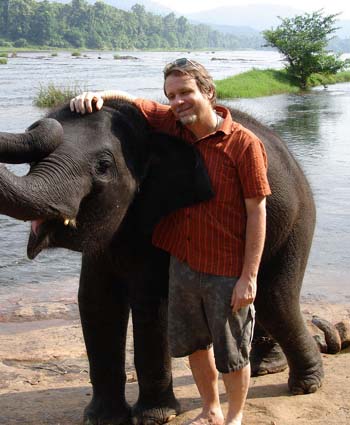 The phrase “signature style” gets thrown around a lot when folks are talking about the work of authors and illustrators, and if you ever meet someone to whom the meaning of that phrase is unclear, just show them the work of Calef Brown. The signature in his style is his and his alone, unlike any other. Sure, you can take his quirky wit and very angular illustrations on a flat plane and liken his style to others’ (the wonderful work of Maira Kalman comes to mind, for one), but no one else does creative proportions, purple faces (and almost every other shade imaginable), distinctive elongated noses, and the overall postmodern folk-art vibe quite like Calef. His art has an energy that jumps off the page, and the best thing about his poetry is that you never quite know what you’re going to get. Happy surprises all around.
The phrase “signature style” gets thrown around a lot when folks are talking about the work of authors and illustrators, and if you ever meet someone to whom the meaning of that phrase is unclear, just show them the work of Calef Brown. The signature in his style is his and his alone, unlike any other. Sure, you can take his quirky wit and very angular illustrations on a flat plane and liken his style to others’ (the wonderful work of Maira Kalman comes to mind, for one), but no one else does creative proportions, purple faces (and almost every other shade imaginable), distinctive elongated noses, and the overall postmodern folk-art vibe quite like Calef. His art has an energy that jumps off the page, and the best thing about his poetry is that you never quite know what you’re going to get. Happy surprises all around.
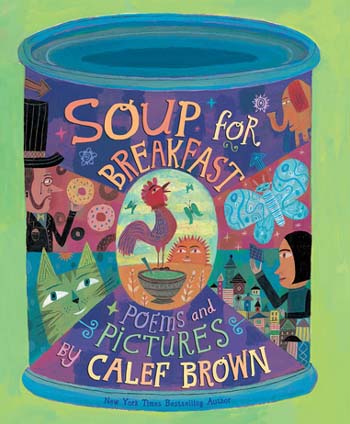 Publishers Weekly—in their review of Calef’s newest title, Soup for Breakfast (Houghton Mifflin, 2008)—touches upon that very thing when they write, “Brown’s…fun-filled poems feature an unpredictable range of topics and imagery.” Best of all, they closed the review with this: “A smorgasbord of punditry and weirdness, this collection will remind kids that poetry and pictures can exist just for kicks.” Just as it should be. Calef strikes again.
Publishers Weekly—in their review of Calef’s newest title, Soup for Breakfast (Houghton Mifflin, 2008)—touches upon that very thing when they write, “Brown’s…fun-filled poems feature an unpredictable range of topics and imagery.” Best of all, they closed the review with this: “A smorgasbord of punditry and weirdness, this collection will remind kids that poetry and pictures can exist just for kicks.” Just as it should be. Calef strikes again.
Calef’s here this morning for a breakfast chat. His devotion to soup for breakfast isn’t just limited to his book titles either:
“…Coincidentally (or not), my latest book is titled Soup for Breakfast, and soup is, in fact, my top choice for a morning meal. Vegetable barley, cream of cauliflower, or anything with mushrooms. When I’m in New York or LA and have access to good South Indian food, my favorite breakfast is idli, pongal, and maybe a couple vadai (spicy donuts). I drink green tea every morning, usually sencha.” Mushroom soup: Mmm. I think I’ll join him in this culinary adventure. Let’s set the table and get the basics from Calef this morning.
Note: Some of Calef’s sketches and illustrations have been re-sized to fit within the blog’s template but are linked to the original file. You can click on those hyperlinked spreads to see them larger and in more detail.
Also, Calef sent a bunch of great sketches that I absolutely must post. I’ll include the ones not included in the interview itself at the bottom of this post for other illustration fans.
7-Imp: Are you an illustrator or author/illustrator?
Calef: Author/Illustrator.
7-Imp: Can you list your books-to-date?
Calef:
Written and Illustrated:
- Polkabats and Octopus Slacks: 14 Stories
- Dutch Sneakers and Fleakeepers: 14 More Stories
- Tippintown: A Guided Tour
- Flamingos on the Roof
- Soup for Breakfast
Illustrated:
- Greece! Rome! Monsters! by John Harris
- Pop-Up Aesop by John Harris
- Gertrude is Gertrude is Gertrude is Gertrude by Jonah Winter
- The Curious Case of Benjamin Button by F. Scott Fitzgerald
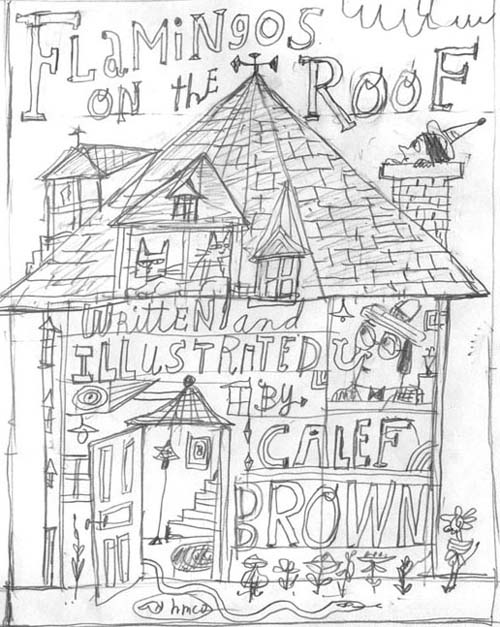
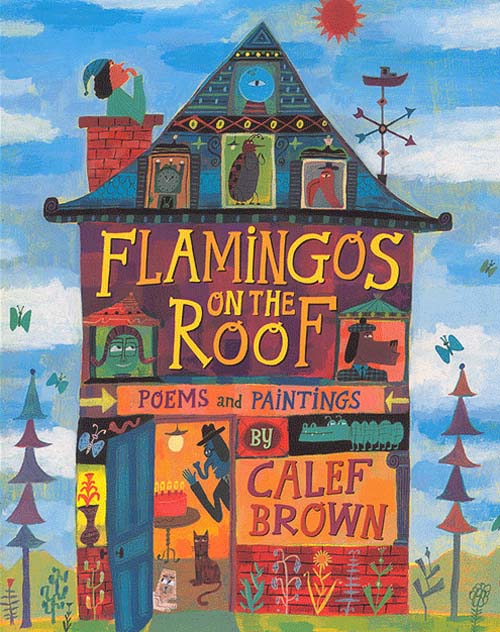
7-Imp: What is your usual medium, or -– if you use a variety -– your preferred one?
Calef: Acrylic and gouache on paper.
7-Imp: If you have illustrated for various age ranges (such as, both picture books and early reader books OR, say, picture books and chapter books), can you briefly discuss the differences, if any, in illustrating for one age group to another?
Tippintown: A Guided Tour, Houghton Mifflin, 2003.
And here and here are two more sketches from the title as well.)
Calef: I’d say all of the books that I’ve written and illustrated appeal to more or less the same age range, although in my first one, Polkabats and Octopus Slacks, the language is a bit more basic than the others. Even if some of the vocabulary is challenging for younger kids, I hope that they will be drawn in by the art and humor and the musicality of the poems. The rhyme schemes hopefully help with learning and pronouncing new words.
I’ve never given much thought to tailoring the books to a specific age group. Overall, they seem to appeal to kids from ages three or four up to ten or eleven.
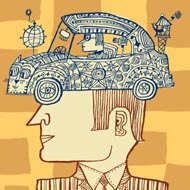 Besides my books, I also do a fair amount of freelance illustration aimed at adults, and my basic approach is not that different. I always want my art to have an immediate graphic impact and also a certain amount of detail and subtlety that will hopefully invite a longer look. I think that there’s humor in my work, whether it’s something for kids or for grown-ups.
Besides my books, I also do a fair amount of freelance illustration aimed at adults, and my basic approach is not that different. I always want my art to have an immediate graphic impact and also a certain amount of detail and subtlety that will hopefully invite a longer look. I think that there’s humor in my work, whether it’s something for kids or for grown-ups.
When I do school visits, I show examples of my editorial illustrations and other freelance work, and some of the strongest reactions—loud outbursts of laughter—are in response to a few of these pieces, which really surprised me at first.
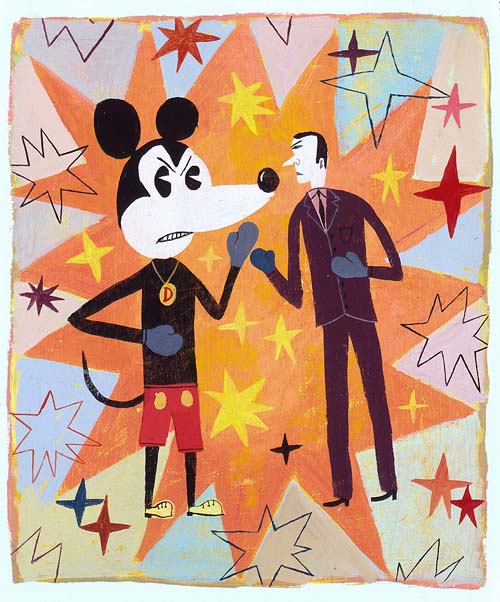
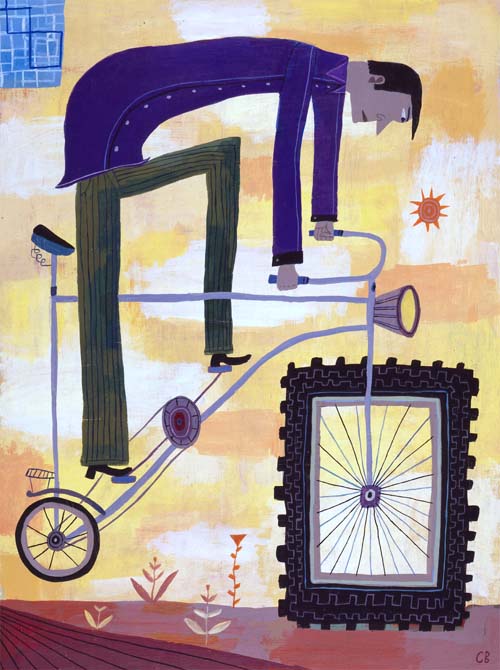
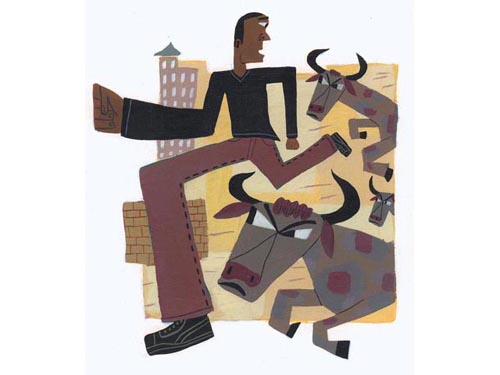
7-Imp: Where are your stompin’ grounds?
Calef: My grounds of stompin’ for many years were the greater Los Angeles area until recently, when my wife and I moved to Maine. A big change, and a happy one. I grew up in the northeast –- Philadelphia, New York, and Boston, and I love New England. I’ve really missed the seasons.
7-Imp: Can you briefly tell us about your road to publication?
Calef: I had been working as a freelance illustrator, doing mostly magazine work, for about four years when I decided that I wanted to try to illustrate something of my own. I wrote Polkabats and Octopus Slacks in 1996. I found that writing short rhyming pieces came more naturally than creating a longer story. I didn’t call them poems at the time, because poetry seemed too serious a term for this sort of nonsense, hence the title Polkabats and Octopus Slacks: 14 Stories. I didn’t have an agent (or a clue about how to sell a book), so I just sent out a dummy to about a dozen publishers, and it was picked up by Margaret Raymo at Houghton Mifflin. She’s a wonderful editor and I have worked with her on all my books of poetry since then. My path to continued publication was also given a huge boost when Daniel Pinkwater read Polkabats on NPR with Scott Simon. I had enjoyed Daniel’s books for many, many years, so it was very gratifying that he appreciated my work.
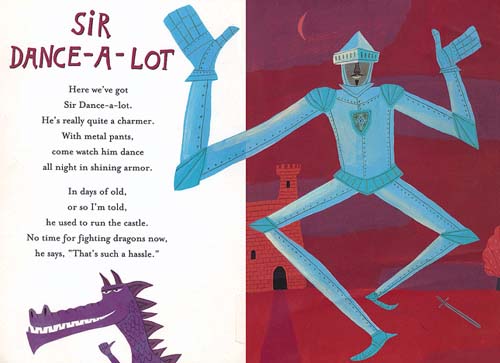
Houghton Mifflin, 2000
7-Imp: Can you please point us to your web site and/or blog?
Calef: My website is calefbrown.com, which has a lot of my freelance illustration work, as well as samples of my books and a selection of paintings done for my own amusement or for gallery shows. It also has an online shop with lots of original art for sale.
Polkabats.com is my blog dedicated to my kids’ books and related stuff.
7-Imp: If you do school visits, tell us what they’re like.
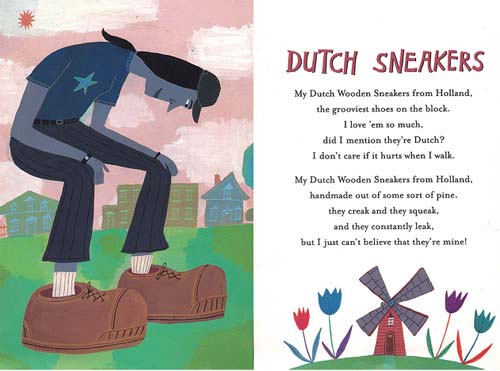
Calef: I have been doing more school visits these days; I really enjoy them. I use Keynote (PowerPoint for Mac) and start with examples of art and books that inspired me as a kid, some of my drawings from my elementary school years (which prove, indisputably, that I wasn’t born with much artistic talent), and my first attempts at putting stories and pictures together. I talk about where the ideas for the poems come from, why I love language and the things I find funny, and go through the process of writing and illustrating a book, from sketches to the printed page. I show a big variety of artwork, read lots of my favorite stuff from the books, and include some simple and creative drawing and poetry exercises. I answer questions at the end, and three of the most popular seem to be:
- Are any of your poems about your family or pets?
- What is your favorite poem that you have written?
- Why did you make yourself a blue elephant on the book flaps?
A: (Yes, “Ed,” and I love elephants and dislike author photos.)
I’ve also been asked if I really paint on toast, wear Dutch wooden sneakers, or keep any pet snails. (The answer is no to two of those questions, and yes to one.)
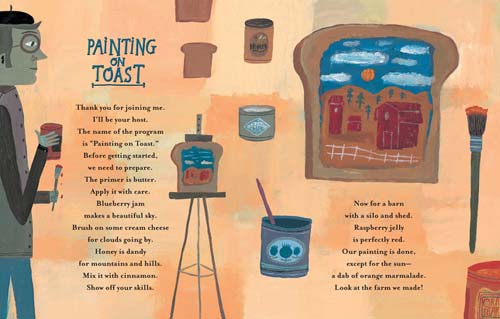
7-Imp: If you teach illustration, by chance, tell us how that influences your work as an illustrator.
Calef: I have taught illustration off and on over the years, most recently at Art Center in Pasadena. I would say that the best way it has influenced my work is to keep me in touch with the spirit of curiosity and the willingness to experiment with style that my students have shown. I loved my own time in art school (I put in twelve semesters to get my BFA; I wasn’t in a hurry) and had fantastic teachers and mentors, who were so generous with their knowledge and experience as artists and illustrators. I try to pass that along.
7-Imp: Any new titles/projects you might be working on now that you can tell us about?
Calef: I’m currently working on a book for Atheneum that is a bit different than the others I’ve written, but involves wordplay and nonsense; a book of poems and pictures in the Halloween spirit for Houghton Harcourt; and I’m very excited to be illustrating a book of the work of one of my literary heroes for Chronicle.
 Okay, the table’s set for our breakfast chat. Soup bowls are ready. Now we’re ready to talk more specifics. Once again, I thank Calef for stopping by.
Okay, the table’s set for our breakfast chat. Soup bowls are ready. Now we’re ready to talk more specifics. Once again, I thank Calef for stopping by.
1. 7-Imp: What exactly is your process when you are illustrating a book? You can start wherever you’d like when answering: getting initial ideas, starting to illustrate, or even what it’s like under deadline, etc. Do you outline a great deal of the book before you illustrate or just let your muse lead you on and see where you end up?
Calef: I try not to think about the visual side at all when I’m writing, although sometimes the ideas themselves originally come out of drawings in my sketchbooks. Once the manuscript is done and I’m happy with it, I start to play around with ideas in the form of thumbnail sketches — lots of doodling. If it’s a collection of poems, I’ll quickly set the type out, think about the shape of the text on the page and try to envision each spread. I also start thinking about the trim size and get some feedback from the art director and my editor about this and other basic choices for the book.
The sketches that I work from, when doing the final art, get refined and become fairly tight, but I like to leave room to adjust things, if I get new ideas during the painting process. I have completely changed course with various illustrations at the last minute when I’ve gotten a better idea for an illustration. I really love the process of figuring out how to best illuminate the poems — to try and come up with the perfect picture for the words. With the exception of Tippintown, the illustrations in the books have been for individual poems—they’re not related chronologically—so I have a lot of freedom to change things as I go.
I work up all the paintings at the same time; I never finish one and go on to the next. I like to see them all developing together, coming into focus as a collection. Sometimes I’ll paint on a group of five one day, another five the next, then groups of two or three. I have never done color studies; I just usually have a picture in my head of how I think color should work for a particular illustration and try to find it in the process, leaving room for happy accidents.
When I’m done with all the interior art, I start to consider the cover, title and contents pages, endpapers, etc. This stage is a lot of fun — frosting on the cake. I usually leave the decision about the order of the poems in the book until I can see all the finished paintings together. Deciding on the order is one of the most difficult things for me; I change my mind a lot and second guess. I want the experience of going from one page to the next to have a particular rhythm, as the individual poems do.
2. 7-Imp: Describe your studio or usual work space for us.
Calef: My studio is a two-room space in an old building on the main street of a small college town. It has nice, high ceilings and a row of tall windows across one wall. Great light. The studio is located on the second floor above a fantastic bookstore called The Gulf of Maine that I have been going to since I was in my early twenties. My wife, Anissa, shares the space with me. In the larger room, we have work tables, bookshelves, and a couch, and in the smaller room computers and scanners, storage, and non-art-making office stuff. Nothing fancy, but a very comfortable place to work.
We also have a studio mate, Bela, who is a formerly stray cat that we coaxed inside on a cold night in January, and she lives there now. We have two other cats and a little chihuahua-terrier at home.
3. 7-Imp: As book lovers, it interests us: What books or authors and/or illustrators influenced you as an early reader?
Calef: I loved Dr. Seuss. The Sleep Book was probably my favorite. I was more intrigued with his drawings than with the words and stories. His feat of creating such a consistent and detailed universe, so odd but still inviting and familiar — the joy I remember when entering into the world of his books has always stayed with me. I thought about this a lot when I was working on my book Tippintown. I wanted all the details—the architecture, plants, clothing, food—to be interesting and inventive, to add to the richness of the imagined place.
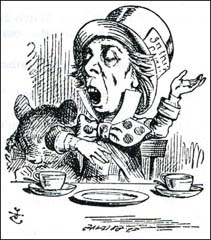 I was given an edition of Alice in Wonderland when I was six or seven, and the Tenniel illustrations blew my mind. My grandmother had quite a few Victorian-era books in her house, and I spent a lot of time there reading and trying to copy illustrations by Peter Newell, Palmer Cox, J.J. Grandville, Edmund Dulac, Arthur Rackham, and others. I loved the combination of whimsy and creepiness in cautionary tales like Slovenly Peter, The Hole Book, and other stuff from that time. I memorized nonsense rhymes and limericks by Lewis Carroll and Edward Lear.
I was given an edition of Alice in Wonderland when I was six or seven, and the Tenniel illustrations blew my mind. My grandmother had quite a few Victorian-era books in her house, and I spent a lot of time there reading and trying to copy illustrations by Peter Newell, Palmer Cox, J.J. Grandville, Edmund Dulac, Arthur Rackham, and others. I loved the combination of whimsy and creepiness in cautionary tales like Slovenly Peter, The Hole Book, and other stuff from that time. I memorized nonsense rhymes and limericks by Lewis Carroll and Edward Lear.
Other favorite picture books — the Little Bear books and A Hole is to Dig, illustrated by Maurice Sendak, as well as his Nutshell Library. I was obsessed with three books by Ingri and Edgar Parin d’Aulaire — Ola and Blakken, The Magic Meadow, and The Terrible Troll Bird. A.A. Milne, Beatrix Potter — my favorite was Two Bad Mice, in part because the name Hunca Munca made me laugh every time I read it. I had all the Babar books, and the spread near the end of Babar the King with the winged elephants chasing away a group of creatures representing fear, sickness, despair, and other maladies is an incredibly powerful image that really captivated my imagination. It’s like an introduction to Hieronymous Bosch for kids.
I loved the This Is books by Miroslav Sasek, and his style has had a big influence on my work.
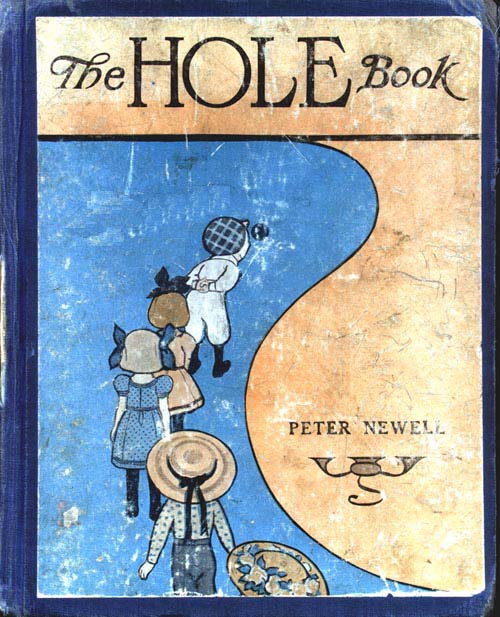
4. 7-Imp: If you could have three (living) illustrators—whom you have not yet met—over for coffee or a glass of rich, red wine, whom would you choose?
Calef: Maurice Sendak, Tomi Ungerer, and Tove Jansson — she died in 2001, but I would have loved to meet her and chat.
5. 7-Imp: What is currently in rotation on your iPod or loaded in your CD player? Do you listen to music while you create books?
Calef: I have a lot of music on my computer, all kinds of stuff, and will often just let it shuffle. I usually like music on when I paint and sometimes (instrumental improvisational music) when I write. Other times, I like silence when working.
6. 7-Imp: What’s one thing that most people don’t know about you?
Calef: My ancestor and namesake, Robert Calef, figured prominently in the era of the Salem witch trials, as a debunker and thorn in the side of gasbag extraordinaire Cotton Mather. A short bio:
CALEF, Robert, author, died about 1723. He was a Boston merchant, and powerfully attacked the witchcraft delusion in a book called More Wonders of the Invisible World (London, 1700; Salem, Massachusetts, 1796). The title was suggested by Cotton Mather’s Wonders of the Invisible World. Calef’s plain facts and common-sense arguments had a powerful effect on public opinion, and contributed much to the decline of the delusion. His book irritated Mather, who called Calef “a weaver turned minister” and “a coal from hell,” and finally prosecuted him for slander. Dr. Increase Mather, president of Harvard College, ordered the wicked book to be burned in the College-yard.
7-Imp: What is your favorite word?
Calef: “Chingleput.”
7-Imp: What is your least favorite word?
Calef: “Synergy.”
7-Imp: What turns you on creatively, spiritually or emotionally?
Calef: Sublime absurdity.
7-Imp: What turns you off?
Calef: Mean-spirited humor, unless it’s really funny.
7-Imp: What is your favorite curse word? (optional)
Calef: “Balderdash!”
7-Imp: What sound or noise do you love?
Calef: Alarmed seagulls.
7-Imp: What sound or noise do you hate?
Calef: Leaf blowers, the soundtrack of Southern California.
7-Imp: What profession other than your own would you like to attempt?
Calef: I would love to be a well respected Enthusiologist with a small, but thriving, private practice.
7-Imp: What profession would you not like to do?
Calef: Longhaul dunglugger.
7-Imp: If Heaven exists, what would you like to hear God say when you arrive at the Pearly Gates?
Calef: “Hey you!! Yeah you, in the chartreuse coveralls! Caleb, or whatever your name is, I’m talking to you! Get back down there and start over… and try to get it right this time!!”
Additional sketches and book dummies from Calef — for other illustration junkies and other Calef fans. Click on each image to see it up close and in detail:
All photos and illustrations—with the exception of the tea pot, Tenniel image, and The Hole Book image—courtesy of Calef Brown. All rights reserved.
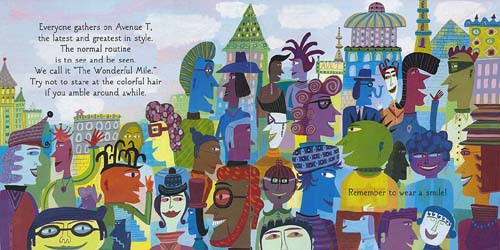
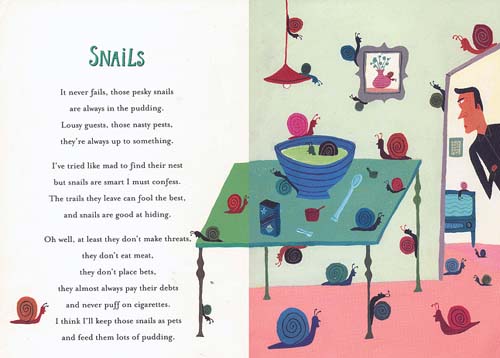
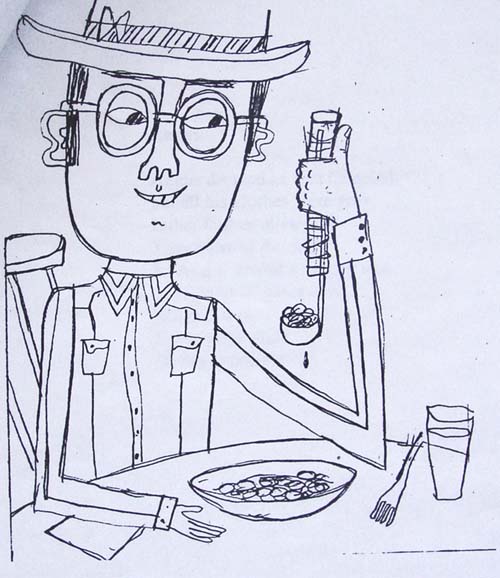
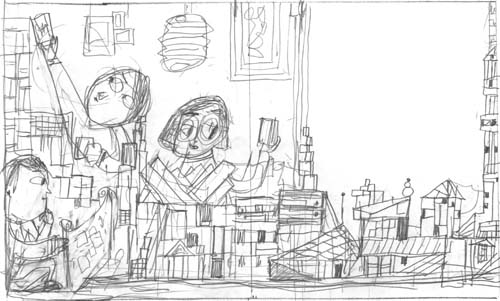
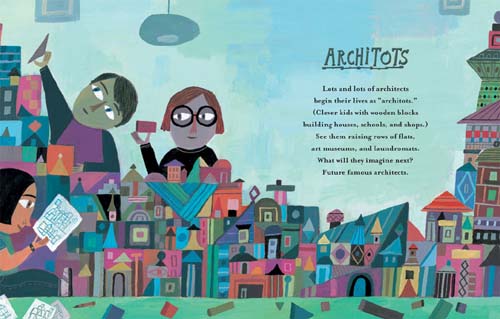
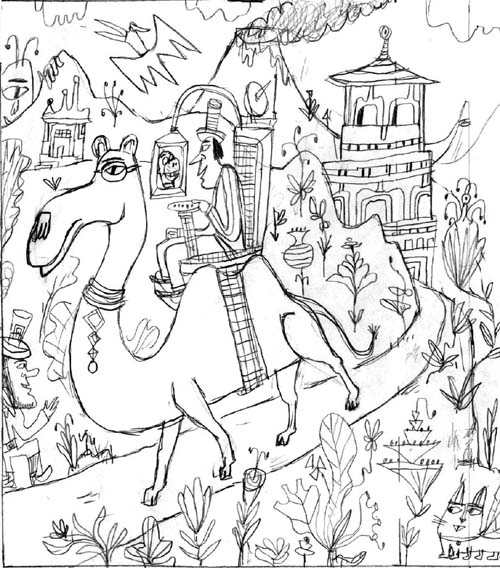

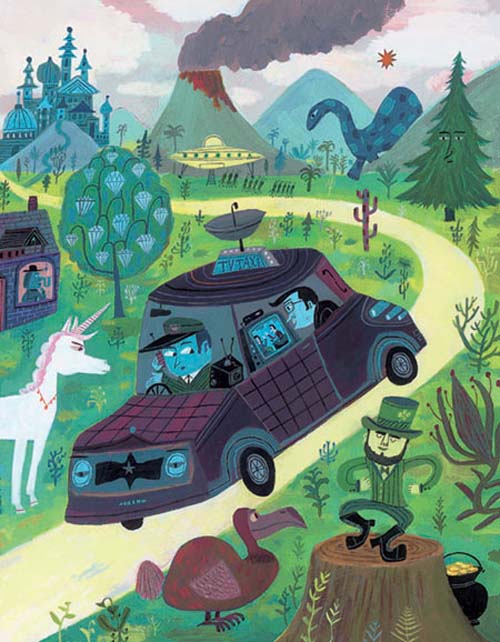
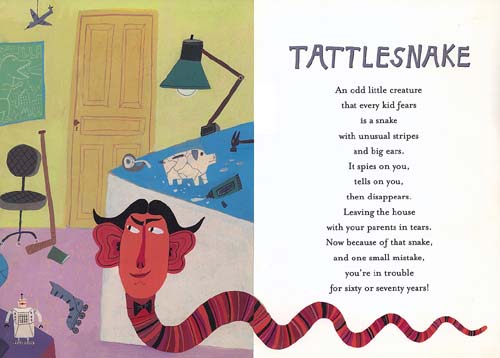
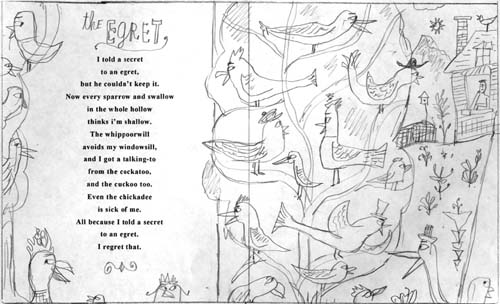
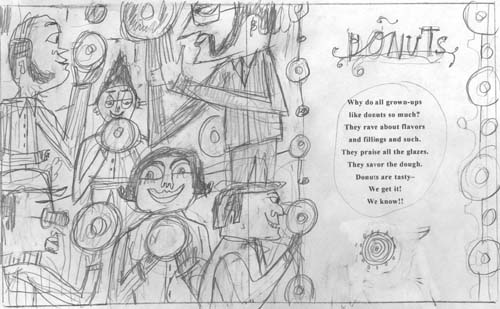

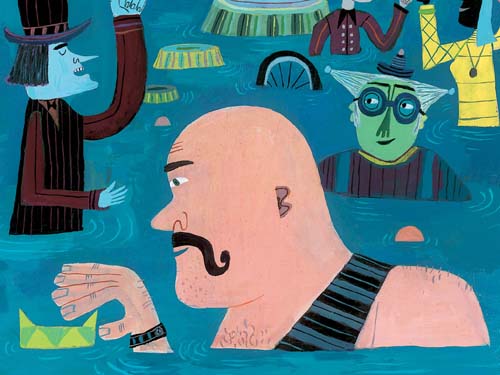

Oh, thank you SO much. Calef Brown is simply one of my all-time faves!! “Sublime absurdity” describes his work perfectly. Haven’t had a chance to see Soup for Breakfast yet. For now, I’m swooning over “Painting on Toast” and all the other spreads. 🙂
loved his work before i saw the children’s stuff and loved it even more after. it’s so great to see the drawing and sketches.
WOW! So much to love about this post, not least all the photos and drawings he shared with you!
I think I’d like to be an Enthusiologist as well. Sounds fun.
What a gorgeous GIANT (and exceedingly complicated to put together, no doubt) feast for the breakfast eyes! As usual around here, a gifted illustrator and the 7-Imp staff have worked hard and wrought a miracle.
Calef Brown’s stuff is wonderful. Because I’m familiar with the 7-Imp “pivot questions,” I knew questions would be upcoming about his influences, favorite illustrators, and so on. So I was surprised when he didn’t mention Saul Steinberg. I mean, CB’s completely his own self — as you mention, the rainbow of faces, the loooong elephant-trunk noses, and so on — but so many of these images say Steinberg to me. Like those two sketches from TV Taxi — see the cat in one, and the bird in the other, at the bottom right corner? Those little creatures could’ve leapt right out of Steinberg’s head, into Calef’s, and out through his pen or pencil. Ditto some of the works hanging on the wall of his studio (like the locomotive guy).
Very cool stuff. Thanks to all concerned for sharing it!
P.S. I’ve always wondered about the age ranges assigned by publishers to children’s books. Do they start out with a readability formula and then adjust it up or down using some seat-of-the-pants method? Do they account for, uh… well, social age as well as chronological?
those sketches are fabulous. it’s so cool to see them lined up with the final products! thanks!
The illustrations are fabulous, but can I just say that as an organizational junkie I LOVE all the boxes and the “neatness” of the studio! *Sigh*
Another wonderful interview.
[…] Fantasic Interview with one of my top 5 favorite illustrators CALEF BROWN. More about CALEF BROWN at: Profile / Spotlight / Website / RSS […]
Fantastic Interview .. so cool looking into Calef’s amazing world.
What an amazing, in-depth interview once again. And thank you for including so many visuals. I’m a huge fan of Calef’s and am so impressed with his dual gifts as poet and artist!
Calhead,
You rock. Great sh*t. Can’t think of a better arrival in heaven…if only I’m there to see it.
I hadn’t seen any of Calef’s work before I read this interview, and now I want to see it ALL and RIGHT NOW. Fantastic interview.
Thanks, you all.
Eisha and I have this ongoing theory that picture book illustrators often look a lot like their dominant style of illustration, like their characters. I’d give an example if I had more coffee in my system. Anyway, Calef surprised me. Not that anyone has azure or lavender skin and/or elephant noses, but I dunno…I just expected him to look entirely different.
Good call on the Saul Steinberg, John. And, Tricia: Yes, Calef and his wife seem mighty organized. Think they’d want to organize my girls’ room if I served an actual breakfast, complete with soup? I know you’ll be interviewing him soon, too, right? I look forward to seeing that.
And, y’all, he sent EVEN MORE sketches than what I showed here. I love it when illustrators do that.
Now here’s an artist who’s who’s prolifically drawing and writing together…and spreading (hopefully widely) a lot of good funky pleasure. Thanks, Calef.
Calef is the envy of every illustrator. Not just a portfolio, but a complete, patented method for capturing the quirky essence of everything, even runaway waffles.
Or maybe all these witty characters are actually refugees from some 2D land experiencing a population explosion, and they’ve somehow managed to arrive in boatloads inside Calef’s head. Quite frightening, really. I fear for Calef’s sanity… the lucky bastard.
Wow! Seeing his sketches only confirms my suspicions… Calef is an amazing (genius) talent. His signature style and wit flows from brain to pen so effortlessly. And from seeing the shelf of sketchbooks, it is a constant flow. For artists (like me) where the process takes many steps of refinement…we are very envious of Calef’s kind of talent.
Thanks, first to Jules for putting this together , and organizing the images in such a way as to make me almost sound coherent. And to everyone for the overly kind comments. JES, you’re right on about Steinberg. Since the question was about influences as an early reader i didn’t include later inspiration like Steinberg, Klee, a slew of outsider and folk artists and many more. Rahul, I fear for my sanity as well…mainly that i’ll regain it, and all my waffles will never leave home. And the veneer of seeming studio organization is a charade for the camera. Happy snails!
I love Brown’s work. What a treat to see such a detailed exploration of his process and studio. Great job, all!
[…] There are sketches of Kansas City Octopus as part of this terrific interview with Calef Brown at Seven Impossible Things Before Breakfast (a blog all book lovers should be […]
[…] Seven Questions—And a Little Bit of Soup—Over Breakfast with Calef Brown April 14th, 2009    by jules […]
Great interview!
wow! i adore calef’s work and am always so interested to see how other author/artists dummy their books. so fun to have a peek and the ascent into calef-land. thank you all!
Thanks so much for getting the word out there about Calef Brown. I am a huge fan of his work, and I too aspire to be a “well respected Enthusiologist.”
Cheers for such wackiness and delight.
-Catherine
Amazing, all that detail from him and I am still curious as to how he uses gouache and acrylic together. I wonder if he paints in his backgrounds in gouache and then does acrylic on top for his figures or vice a versa. Eh… maybe both!! Such a fantastic talent! Great seeing all the dummies and the studio shots!
I was lucky enough to have been a student of Calef Brown’s at Otis, a couple of years before Polka Bats and Octopus Slacks came out. He was and continues to be an inspiration. I always read that book out loud on Read Across America Day (which is today) and it never fails to get the kids excited. Today when I reached the end, the kids all asked me to read “Funky Snowman” again and they all got up and danced along.
[…] vibe? Kirkus describes Waldron’s digitally-created art as “a delightful cross between Calef Brown and J. Otto […]
I’ve been inspired by Calef Brown for years. What a great human. One who writes, paints, thinks and feels and sounds humble to boot. Hats off to Caleb.
[…] Calef Brown (hiding behind his book here to the left) brings us that opening illustration there, one of the endpaper tests, he told me, for his latest poetry collection, Hallowilloween: Nefarious Silliness from Calef Brown (Houghton Mifflin, September 2010). I think celebrating Halloween with Calef makes all the sense in the world, as he’s the Reigning Children’s Poet of Weird (that’s a compliment) and so convincing at having us see the world a different way (not unlike Halloween), so I invited him to share today some of the illustrations and poems from this title. The book celebrates the holiday with the Grim Reaper (and what his suppers might be like), the Poltergeyser (in a certain national park), a scarecrow and his epitaph (seven guesses as to what it might be), Jack (the rare wolf), a vumpire (who only works night games), and many more, some of which can be seen below. School Library Journal writes, “Brown’s acrylic illustrations add to the creepy silliness: an artful mix of naive and stylized, whimsical details and vibrant color.” […]
[…] is a combination of poets, teachers, editors/anthologists, professors, and librarians. It includes Calef Brown, Shannon Collins, Julie Danielson, Rebecca M. Davis, Rebecca Kai Dotlich, Janet Fagal, Charles […]
Thank you for the sensible critique. Me & my neighbor were just preparing to do some research on this. We got a grab a book from our area library but I think I learned more from this post. I’m very glad to see such great info being shared freely out there.
You completed certain good points there. I did a search on the matter and found most persons will go along with with your blog.
Its great as your other blog posts : D, thanks for posting.
I would like to express my respect for your kind-heartedness giving support to individuals who have the need for assistance with your subject matter. Your personal dedication to passing the solution along appears to be quite important and has regularly encouraged individuals like me to realize their goals. Your amazing important help and advice implies so much a person like me and extremely more to my colleagues. Warm regards; from each one of us.